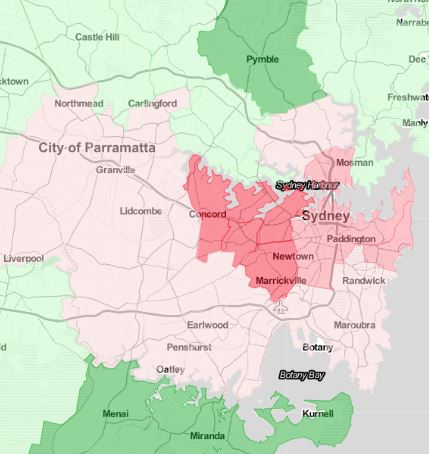A recent analysis of the quantum of open space across Sydney Local Government Areas (LGAs) found a wide variation from 10.1 square metres/per person (sqm/pp) in Burwood to 117.3 sqm/pp in Kuringai.

The average across Sydney. The Sydney average is 75 sqm/pp. The median is 45.4 sqm/pp.
So how did Willoughby rate? With 45.1 sqm/pp (the median figure) Willoughby sits square in the centre of Sydney LGAs. However, this is well below the city wide average of 75 sqm/pp.
The relative amount of open space across the city is generally as would be expected.
- Low/very low (10-20 sqm/pp) in the City, North Sydney, Inner West and the eastern suburbs
- Medium (20-100 sqm/pp) across most of the city. This comprises suburbs with 20-55 sqm/pp generally along the Parramatta Rive basin (and includes Willoughby) and suburbs to the nort and southwest with 55-100 sqm/pp).
- High (100-850 sqm/pp in the Blue Mountains, Sutherland and Kuringai
Is this enough open space?

Traditionally, planning guidelines provided for a far greater amount of open space per person. Back in the 1920/30s the guidelines were for around 25-30 sqm/pp. By the 1940s, this had reduced to 15 sqm/pp. The current World Health Organisation guideline is for 9 sqm/pp in urban area. With the increasing pace of urbanization we may soon see the recommendation drop to 5 sqm/pp.
At 45 sqm/pp, Willoughby is relatively well provided with open space. However, with increased urban densities we are likely to see that figure fall. It is very difficult and costly to provide more open space in a growing city. Apart from a small amount of open space that might be achieved by the creation of roof top gardens, the only other way is to bulldoze the traditional homes and replace them with high-rise buildings with generous setback. The more open space sought, the higher the buildings must be.
Even by creating more open space by re-architecting the city we may not create high quality spaces. A lot of the open space that could be created ends up being small, passive open spaces (sometimes called pocket parks). The opportunity in high density areas is to create active, connected spaces. This can be done with the creation of walking and cycle tracks, both on existing pavements, or by the creative linking of green spaces. This process is often referred to a creating a ‘green web’ throughout the city.
Source: O’Sullivan M. & Singhal P, 2020, Rush outside reveals green divide, Sydney Morning Herald, Saturday 23 May p.18
___________________________________________________
To become or renew as a member of CWWPA before March 30, direct deposit $10* with your name in the reference field to BSB: 032090 Acct: 548083 & complete our Membership Application. *Non-refundable subject to meeting membership criteria.